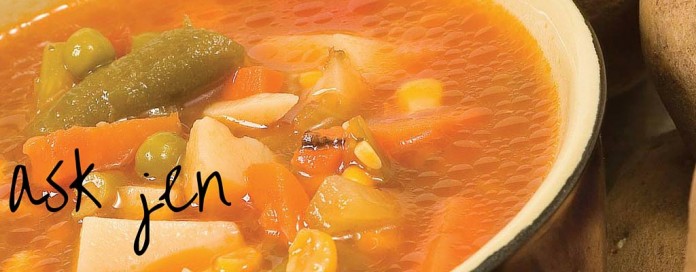‘Tis the season for a long, cold, fall and winter filled with food that’s (unfortunately) bound to add on a couple of pounds. We just want to warm up. Who doesn’t want to come inside after a blustery cold day of raking leaves to a giant bowl of steaming hot, thick, chunky beef stew? Add in a loaf of homemade bread and you’ve just hit the comfort food lottery.
Where can I cash in my ticket? I’ll even bring my own spoon …
Seriously, Farm and Dairy has the best readers on the planet. This week, our Around the Table recipe page is 100% reader submitted, with the exception of our feature. That tells me that I’m not the only one who gets excited about cold-weather cooking.

- Meat is not meat. I mean, it is, but when buying beef for stew, it’s not necessary to buy the super-lean expensive cuts. My advice is to go with a tougher cut, like chuck, because it will break down during the slow-cooking process and become really tender and delicious. Chuck is good for the budget, too!
- Speaking about a tough cut like chuck, make sure not to hurry it along. Remember this tip if it’s the only thing you take from this list: Low and slow. Unless you hate stew and don’t care how it turns out, “LOW AND SLOW.” Low heat for a couple hours in the slow cooker.
- Solo stew is just a sin. Never, ever serve that culinary masterpiece alone. You’ll need a good bread or scoop of noodles to soak up the gravy at the bottom of your bowl. No morsel gets left behind.
All veggies are not created equal. For a stew that will be cooking for several hours, you need to pick hearty root vegetables like potatoes, carrots, turnips and rutabaga. Mushrooms are also a good choice that can handle the low and slow method. Other veggies like snow peas have their place in the stew, but may require a shorter cooking time, so add them later.
- Size matters. Cutting your meat and veggies into pieces that are too large will hinder their ability to cook thoroughly. Cutting them too small will cause over-cooking, leaving the veggies especially, mushy, mis-shapen, and flavorless. As a rule of thumb, 1” pieces (or very slightly smaller) are best for both meat and veggies. Now, for veggies that add flavor only, like onion and garlic, cooking them down to nothing is perfectly acceptable.
There you have it! My two cents on stew cooking.
Go make something awesome,
Jen
Get more "Ask Jen" in your inbox each week by getting Around the Table.
It's a FREE weekly e-newsletter all about food. Sign Up Today!







 All veggies are not created equal. For a stew that will be cooking for several hours, you need to pick hearty root vegetables like potatoes, carrots, turnips and rutabaga. Mushrooms are also a good choice that can handle the low and slow method. Other veggies like snow peas have their place in the stew, but may require a shorter cooking time, so add them later.
All veggies are not created equal. For a stew that will be cooking for several hours, you need to pick hearty root vegetables like potatoes, carrots, turnips and rutabaga. Mushrooms are also a good choice that can handle the low and slow method. Other veggies like snow peas have their place in the stew, but may require a shorter cooking time, so add them later.









